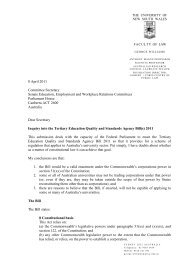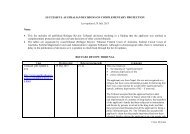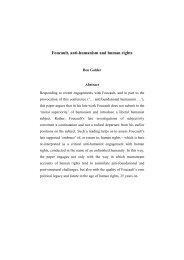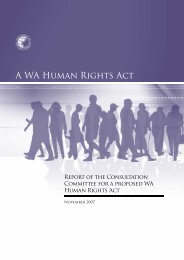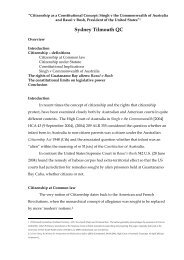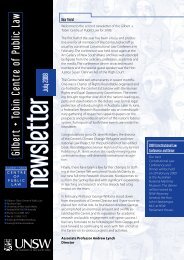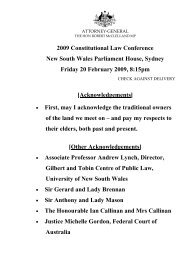Dummy Template - Customised LetterHead - Gilbert + Tobin Centre ...
Dummy Template - Customised LetterHead - Gilbert + Tobin Centre ...
Dummy Template - Customised LetterHead - Gilbert + Tobin Centre ...
You also want an ePaper? Increase the reach of your titles
YUMPU automatically turns print PDFs into web optimized ePapers that Google loves.
THE UNIVERSITY OF<br />
NEW SOUTH WALES<br />
FACULTY OF LAW<br />
16 March 2010<br />
Committee Secretary<br />
Senate Legal and Constitutional Affairs Committee<br />
Parliament House<br />
Canberra ACT 2600<br />
Dear Secretary<br />
Inquiry into the Wild Rivers (Environmental Management) Bill 2010 [No 2]<br />
Thank you for the invitation to make a submission to the Committee’s inquiry into the Wild Rivers<br />
(Environmental Management) Bill 2010 [No 2] (‘the Bill’). We make this submission in our capacity<br />
as members of the <strong>Gilbert</strong> + <strong>Tobin</strong> <strong>Centre</strong> of Public Law and staff of the Faculty of Law, University<br />
of New South Wales. We are solely responsible for its contents.<br />
In this submission we examine the validity of the Bill under section 51(xxvi) of the Constitution, the<br />
races power. Section 51(xxvi) provides that:<br />
The Parliament shall, subject to this Constitution, have power to make laws for the peace,<br />
order, and good government of the Commonwealth with respect to: -<br />
...<br />
(xxvi.) The people of any race for whom it is deemed necessary to make special laws.<br />
The Bill in section 4(1)(a) explicitly relies on this provision as its primary, though not exclusive,<br />
base of constitutional power. Additionally, it purports to be a ‘special measure for the advancement<br />
and protection of Australia’s indigenous people,’ specifically the traditional owners of native title<br />
land in wild river areas of Queensland regulated by the Wild Rivers Act 2005 (Qld).<br />
We consider below each of the criteria for a valid enactment under the races power in regard to the<br />
Bill.<br />
‘People of any race’<br />
The High Court has interpreted this phrase as being broad in its scope. As Brennan J observed, ‘race’<br />
‘is not a term of art.’ 1 He outlined the range of features that may cause a group to identify itself, or<br />
be identified by others, as a race, including their ‘common history, religion, spiritual beliefs or<br />
1 Commonwealth v Tasmania (Tasmanian Dam Case) (1983) 158 CLR 1 at 243.<br />
SYDNEY 2052 AUSTRALIA<br />
Email: george.williams@unsw.edu.au<br />
Telephone: 0414 241 593<br />
Web: www.gtcentre.unsw.edu.au
culture, as well as ... their biological origins and physical similarities.’ 2 Additionally, Deane J<br />
believed that the term has a ‘wide and non-technical meaning.’ 3<br />
There is no doubt that Aboriginal people constitute ‘people of any race’ for the purposes of the races<br />
power. The phrase has also been found by the High Court to encompass any particular ‘sub-group’<br />
within Australia’s Indigenous population. 4 As such, it is within the power of the Commonwealth to<br />
legislate specifically for Aboriginal communities in wild river areas.<br />
‘Deemed necessary’<br />
In Kartinyeri v Commonwealth (Hindmarsh Island Bridge Case), 5 Gaudron J, while emphasising that<br />
it is for Parliament to determine whether a law is necessary or not, considered that there needs to be<br />
some difference pertaining to the particular race or their circumstances. There also needs to be some<br />
material on which Parliament has based its judgment that a difference of this nature exists. Thus,<br />
Gaudron J concluded that an enactment relying on the races power must be ‘appropriate and adapted<br />
to a relevant difference.’ 6<br />
The significance, if any, of this particular phrase remains unresolved by the High Court. However,<br />
the Bill appears to satisfy this criterion nonetheless. The disadvantage experienced by Aboriginal<br />
people is well documented and widely acknowledged. The purpose of the Bill is to secure Aboriginal<br />
communities in the Cape York area economic opportunities stemming from the use, development<br />
and control of the land over which they hold native title. Consequently, if a condition such as that<br />
described by Gaudron J applies, the Bill would likely fulfil it.<br />
‘Special laws’<br />
For legislation to validly rely on the races power, it must apply to a particular race, and not to all<br />
races. For example, in Koowarta v Bjelke-Petersen (1982) 153 CLR 168, the High Court held that<br />
the Racial Discrimination Act 1975 (Cth) was not a valid law under section 51(xxvi) as it provided<br />
protection from discrimination to all races. Thus, it could not be considered a ‘special law’ for the<br />
‘people of any race’.<br />
The High Court expanded on what constitutes a ‘special law’ in Commonwealth v Tasmania<br />
(Tasmanian Dam Case) 7 . It was suggested by Brennan J that the law need not be special in its terms,<br />
but that it is sufficient for it to discriminate in favour of a people in its operation. Additionally, in<br />
Western Australia v Commonwealth (Native Title Act Case) 8 it was held that the special quality of a<br />
law needs to be ‘ascertained by reference to its differential operation upon the people of a particular<br />
race.’ 9 When the law ‘confers a right or benefit or imposes an obligation or disadvantage especially<br />
on the people of a particular race,’ 10 it will be a ‘special law’ for the purpose of the races power.<br />
2 Commonwealth v Tasmania (Tasmanian Dam Case) (1983) 158 CLR 1at 244.<br />
3 Commonwealth v Tasmania (Tasmanian Dam Case) (1983) 158 CLR 1 273-274.<br />
4 Commonwealth v Tasmania (Tasmanian Dam Case) (1983) 158 CLR 1 at 274 and Kartinyeri v<br />
Commonwealth (Hindmarsh Island Bridge Case) (1998) 195 CLR 337.<br />
5 Kartinyeri v Commonwealth (Hindmarsh Island Bridge Case) (1998) 195 CLR 337.<br />
6 Kartinyeri v Commonwealth (Hindmarsh Island Bridge Case) (1998) 195 CLR 337 at 365-366.<br />
7 (1983) 158 CLR 1.<br />
8 (1995) 183 CLR 373.<br />
9 Western Australia v Commonwealth (Native Title Act Case) (1995) 183 CLR 373 at 460-461.<br />
10 Western Australia v Commonwealth (Native Title Act Case) (1995) 183 CLR 373 at 461.<br />
2
The Bill explicitly concerns the interests of Aboriginal people in wild river areas. The economic<br />
opportunities it potentially provides by allowing the native title owners to use, develop and control<br />
their land may also benefit other people. However, this is likely to be a peripheral consequence, with<br />
the primary benefit being conferred to the traditional owners of native title land in being able to<br />
make such decisions about their land.<br />
We conclude that the Wild Rivers (Environmental Management) Bill 2010 [No 2] meets the criteria<br />
to be a valid enactment under s 51(xxvi) of the Constitution.<br />
Inconsistency<br />
Under s 109 of the Constitution, the laws of the Commonwealth prevail over the laws of a State to<br />
the extent of any inconsistency. The Wild Rivers Act 2005 (Qld) empowers the relevant Minister to<br />
make a wild river declaration in order to preserve the ‘natural values’ of that area. Consequently,<br />
future development and other activities must meet certain conditions before they will be authorised.<br />
The Bill on the other hand provides in s 5 that a wild river area subject to native title cannot be<br />
regulated in this manner without the consent of the Aboriginal traditional owners. If the Bill is<br />
enacted, it would be inconsistent with the Wild Rivers Act 2005 (Qld). The High Court held in Clyde<br />
Engineering Co Ltd v Cowburn (1926) 37 CLR 466 that s 109 will be engaged where one law claims<br />
to confer a right or entitlement that another law attempts to eradicate or diminish. The Wild Rivers<br />
Act 2005 (Qld) diminishes the decision-making power of Aboriginal native title holders over their<br />
land as would be conferred by the Bill.<br />
Enacting the Wild Rivers (Environmental Management) Bill 2010 [No 2] would render the Wild<br />
Rivers Act 2005 (Qld) inoperative to the extent of the inconsistency. Thus, the Queensland<br />
government would not be able to regulate wild river areas that are also subject to native title without<br />
first obtaining agreement from the Aboriginal traditional owners.<br />
Yours sincerely<br />
Professor George Williams<br />
Anthony Mason Professor<br />
and Foundation Director<br />
Ms Emily Collett<br />
Social Justice Intern<br />
3



